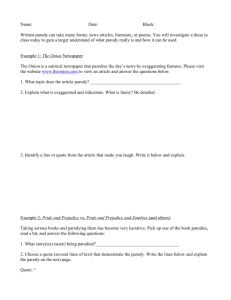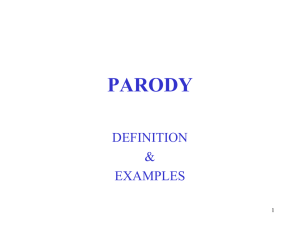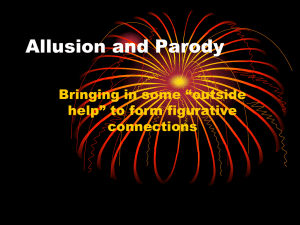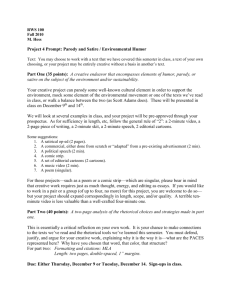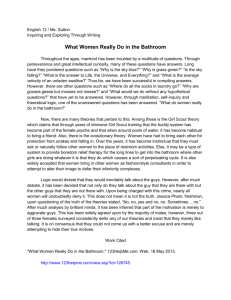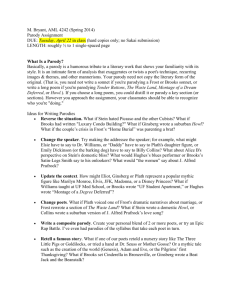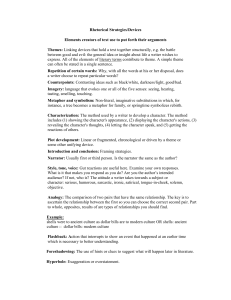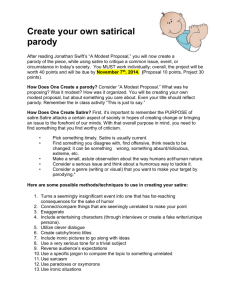What`s so funny about parody? - Patenting Art and Entertainment
advertisement
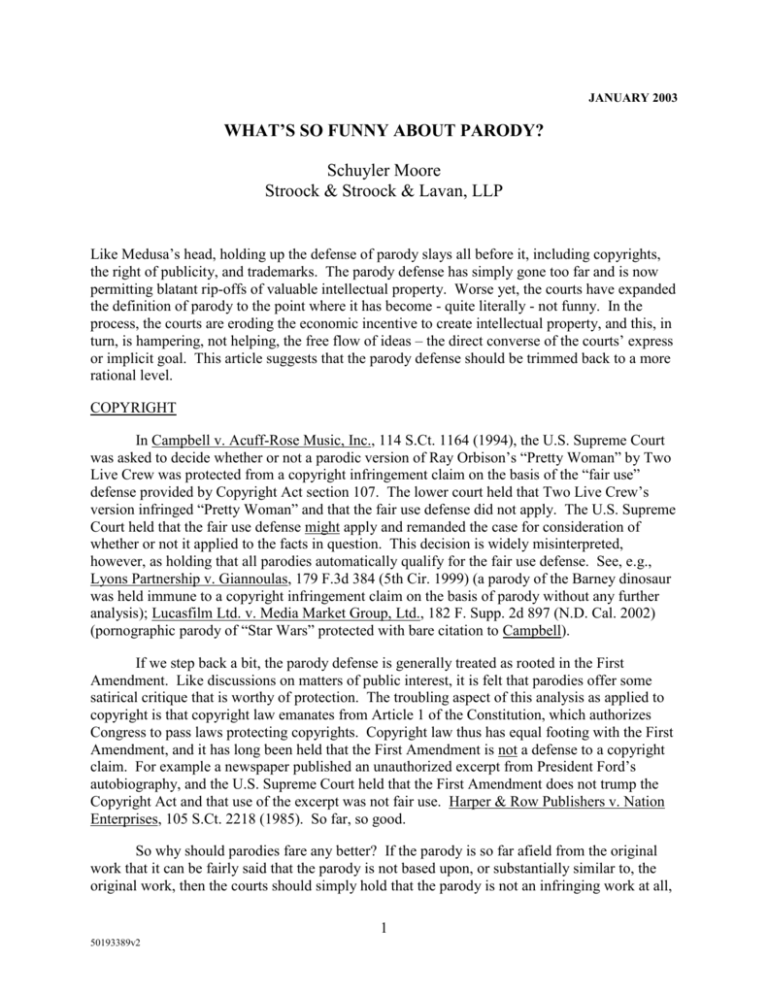
JANUARY 2003 WHAT’S SO FUNNY ABOUT PARODY? Schuyler Moore Stroock & Stroock & Lavan, LLP Like Medusa’s head, holding up the defense of parody slays all before it, including copyrights, the right of publicity, and trademarks. The parody defense has simply gone too far and is now permitting blatant rip-offs of valuable intellectual property. Worse yet, the courts have expanded the definition of parody to the point where it has become - quite literally - not funny. In the process, the courts are eroding the economic incentive to create intellectual property, and this, in turn, is hampering, not helping, the free flow of ideas – the direct converse of the courts’ express or implicit goal. This article suggests that the parody defense should be trimmed back to a more rational level. COPYRIGHT In Campbell v. Acuff-Rose Music, Inc., 114 S.Ct. 1164 (1994), the U.S. Supreme Court was asked to decide whether or not a parodic version of Ray Orbison’s “Pretty Woman” by Two Live Crew was protected from a copyright infringement claim on the basis of the “fair use” defense provided by Copyright Act section 107. The lower court held that Two Live Crew’s version infringed “Pretty Woman” and that the fair use defense did not apply. The U.S. Supreme Court held that the fair use defense might apply and remanded the case for consideration of whether or not it applied to the facts in question. This decision is widely misinterpreted, however, as holding that all parodies automatically qualify for the fair use defense. See, e.g., Lyons Partnership v. Giannoulas, 179 F.3d 384 (5th Cir. 1999) (a parody of the Barney dinosaur was held immune to a copyright infringement claim on the basis of parody without any further analysis); Lucasfilm Ltd. v. Media Market Group, Ltd., 182 F. Supp. 2d 897 (N.D. Cal. 2002) (pornographic parody of “Star Wars” protected with bare citation to Campbell). If we step back a bit, the parody defense is generally treated as rooted in the First Amendment. Like discussions on matters of public interest, it is felt that parodies offer some satirical critique that is worthy of protection. The troubling aspect of this analysis as applied to copyright is that copyright law emanates from Article 1 of the Constitution, which authorizes Congress to pass laws protecting copyrights. Copyright law thus has equal footing with the First Amendment, and it has long been held that the First Amendment is not a defense to a copyright claim. For example a newspaper published an unauthorized excerpt from President Ford’s autobiography, and the U.S. Supreme Court held that the First Amendment does not trump the Copyright Act and that use of the excerpt was not fair use. Harper & Row Publishers v. Nation Enterprises, 105 S.Ct. 2218 (1985). So far, so good. So why should parodies fare any better? If the parody is so far afield from the original work that it can be fairly said that the parody is not based upon, or substantially similar to, the original work, then the courts should simply hold that the parody is not an infringing work at all, 1 50193389v2 and there is no need to rely on the fair use defense. But if, as is usually the case, the parody would be an infringing work but for the fair use defense, the current trend of the courts is to roll over on their backs and surrender to the defense of parody. But why? As discussed above, waving the specter of the First Amendment gets us nowhere, and with that chimera behind us, the naked defense of parody seems rather lame. Let’s look again at Ray Orbinson’s song, “Pretty Woman.” Am I free to create a classical version of the song? A jazz version? A hip-hop version? A tragic version? Of course not. All of these versions would be copyright infringement, and any fair use defense would be scoffed at. So why am I allowed to create a parodic version? Because it is funny? If the protection of parody is not based on the First Amendment – as it cannot - then what is it based on? The parody defense becomes outright scary when the definition of parody is expanded beyond humor. In a pivotal case on this question, the Eleventh Circuit upheld a parody defense for a book called “The Wind Done Gone” against a copyright claim brought by the owner of “Gone With the Wind.” Suntrust Bank v. Houghton Mifflin Company, 268 F.3d 1257 (11th Cir. 2001). Critically, the court held that parody need not be humorous and only had to “comment upon or criticize a prior work.” This definition expands parody beyond all recognition. If the Two Live Crew decision was the camel’s nose under the tent, this is the camel. Under traditional notions of copyright law, “The Wind Done Gone” is nothing more than an unauthorized dramatic derivative work. Under this decision, however, copyright pirates are now free to roam at will creating new versions of copyrighted works, as long as the new versions somehow “comment upon or criticize [the] prior work.” RIGHT OF PUBLICITY The parody defense is also being successfully used against right of publicity claims. Cardtoons, LLC v. Major League Baseball Players Ass’n, 95 F.3d 959 (10th Cir 1996) (no liability for parodic baseball cards featuring baseball players). The logical extreme of this trend is exemplified in a Ninth Circuit case holding that Los Angeles Magazine had the right to publish a computer generated fashion spread of celebrities dressed in clothes made by advertisers in the magazine, including Dustin Hoffman in a dress (and not the one he wore in “Tootsie”). Hoffman v. Capital Cities/ABC, Inc., 255 F.3d 1180 (9th Cir. 2001). Although the Ninth Circuit gave no logical rationale for its decision at the time, a later Ninth Circuit case justified the Hoffman decision on the basis of parody in dicta. Mattel, Inc. v. MCA Records, 296 F.3d 894 9th Cir. 2002). The Hoffman case, as reinterpreted by Mattel, shows the danger of permitting the purported parody defense for the following reasons: A. on a man. The parody, if any, did not relate to Dustin Hoffman; it related to placing a dress B. Whatever parody there was would certainly not fall within the First Amendment; it was a computer generated photograph of Dustin Hoffman in a dress he never actually wore, which did not remotely rise to the level of a matter of public interest. When the parody is a subset of the First Amendment, such as a critical comment on a matter of public interest or a criticism of a public figure, then the outcome in these cases is at least defensible; the right of publicity does not have any constitutional moorings, so the First 2 50193389v2 Amendment trumps a state law right of publicity claim. On this basis, the U.S. Supreme Court's decision upholding the right of Hustler to publish a highly offensive cartoon parodying Jerry Falwell is defensible. Hustler Magazine, Inc. v. Falwell, 108 S.Ct. 876 (1988). But the courts are now giving parodies carte blanche protection with no other rationale. All parodies now appear to be, quite literally, above the law. What is so sacrosanct about all parodies that they deserve First Amendment protection? If I am not free to slap a celebrity's image on a commercial product to sell, why am I allowed to slap it on any parody to sell? TRADEMARK The parody defense is also steamrolling the federal Trademark Anti-Dilution Act, which prohibits the commercial use of another company’s famous trademark in a manner that would dilute the trademark, including by tarnishing or blurring the trademark. In several cases, uses of a trademark that would otherwise be a blatant violation of this act have been held protected as a sacrosanct parody. In the most egregious case to date, a pornographer was permitted to title and advertise a film under the name “Starballz,” a rip-off of the “Star Wars” trademark. Lucas Film Ltd. v. Media Market Group, Ltd., 182 F.Supp. 2d 897 (N.D. Cal. 2002). Another case permitted the commercial use of the famous Barney Dinosaur and trademark on the basis of parody without any further analysis. Lyons Partnership v. Giannoulas, 179 F.3d 384 (5th Cir. 1999). Most recently, the Ninth Circuit permitted use of the Barbie trademark in both the name and lyrics of a song, once again on the basis of parody. Mattel Inc. v. MCA Records, 296 F.3d. 894 (9th Cir. 2002), cert. denied, 71 U.S.L.W. 3503 (2003). All of these cases recite the mantra that a parody is not a commercial use, and thus one of the requirements of the Anti-Dilution Act (i.e., a commercial use) is not present. In each case, however, the uses were undeniably commercial, and it was simply the courts’ ipse dixit rulings that managed to change night to day. If the cases had not involved parodies, the trademark use in question would absolutely have been prohibited. The First Amendment alone does not override the Anti-Dilution Act, or every otherwise prohibited use of a trademark would be permitted by the First Amendment. Thus, parodies have been elevated even above the First Amendment. CONCLUSION In summary, the parody defense now has wings of its own, and is no longer tethered to logic, law, the First Amendment, or anything else. So just what is so funny about parodies that permits them to ride roughshod over intellectual property rights? Why, it’s enough to make one lose one’s sense of humor, particularly when the parody need not be humorous, as in the case of “The Wind Done Gone.” It is time to bring this Pegasus back to earth. 3 50193389v2
